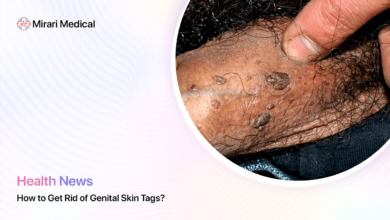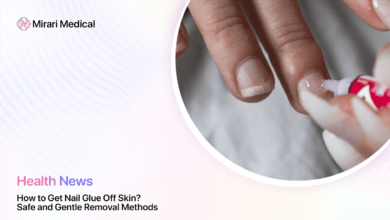Can Castor Oil Remove Skin Tags? Examining the Claims

You may be interested
Skin tags are a common skin concern, and many people seek natural remedies for removal. Castor oil is a popular option, but does it truly work? This guide explores the science behind castor oil and its potential effectiveness for skin tag removal.
Unveiling the Truth: Does Castor Oil Really Work for Skin Tags?
When it comes to using castor oil for skin tags, there is limited scientific evidence to support its effectiveness. While anecdotal reports exist of individuals successfully removing skin tags with castor oil, more research is needed to confirm these claims.
Castor oil does have some theoretical benefits that could potentially aid in skin tag removal. It contains ricinoleic acid, which has been shown to have anti-inflammatory properties. This may help soothe the skin around the tag and potentially promote healing.
However, it’s important to approach these claims with caution. As Dr. Joshua Zeichner, director of cosmetic and clinical research at Mount Sinai Hospital, notes:
“While castor oil has traditionally been used for various skin concerns, more scientific research is needed to confirm its effectiveness for skin tag removal.”
Before attempting to use castor oil or any home remedy for skin tags, it’s always best to consult with a dermatologist. They can provide personalized advice based on your specific skin type and the nature of your skin tags.
Considering Safety: Potential Risks and Precautions with Castor Oil
While castor oil is generally considered safe for topical use, there are some precautions to keep in mind. Before applying it to your skin tags, it’s wise to do a patch test on a small area of skin to check for any irritation or allergic reaction.
Apply a small amount of castor oil to your inner wrist or elbow and wait 24 hours. If no redness, itching, or other signs of irritation occur, it should be safe to use on your skin tags. However, if you do experience any adverse reactions, discontinue use immediately.
Essential Safety Tip: Never Ingest Castor Oil
It’s crucial to remember that while castor oil is safe for topical use, it should never be ingested. Castor oil can be toxic if swallowed and may cause serious health problems such as:
- Abdominal cramps
- Diarrhea
- Dizziness
- Shortness of breath
- Chest pain
If you or someone else accidentally ingests castor oil, seek medical attention immediately. Castor oil ingestion can be life-threatening, so it’s essential to keep it out of reach of children and pets.
Exploring Alternatives: Effective Methods for Skin Tag Removal
If you’re unsure about using castor oil for your skin tags or have not had success with it, there are several other options to consider. The most effective and safest methods involve consulting with a dermatologist.
Dermatologist Consultation: Recommended for Diagnosis and Professional Removal
Before attempting any at-home remedies, it’s always best to have your skin tags evaluated by a dermatologist. They can confirm that the growths are indeed skin tags and rule out any other potential skin conditions that may require different treatment.
Your dermatologist can also discuss the various professional removal options available, which may include:
- Cryotherapy: Freezing the skin tag off with liquid nitrogen
- Electrosurgery: Burning the skin tag off with an electric current
- Excision: Cutting the skin tag off with surgical scissors or a scalpel
- Laser therapy: Using a laser to destroy the skin tag
The best removal method for you will depend on factors such as the size and location of your skin tags, as well as your personal preferences. Your dermatologist can help you weigh the pros and cons of each option and develop a treatment plan tailored to your needs.
Consulting a Dermatologist: Why It Matters
While it may be tempting to try to remove skin tags on your own, there are several compelling reasons to consult with a dermatologist instead. Here’s why seeing a professional matters:
Accurate Diagnosis: Ensures the Growth Is a Skin Tag
Not all skin growths are skin tags. Some may be other types of benign lesions, such as moles or seborrheic keratoses. In rare cases, a growth that appears to be a skin tag could actually be a sign of a more serious condition, such as skin cancer.
By seeing a dermatologist, you can have peace of mind knowing that your growth has been accurately diagnosed. Your dermatologist can perform a thorough skin exam and, if necessary, perform a biopsy to confirm the nature of the growth.
Safe and Effective Removal: Minimizes Risk of Scarring or Infection
While home remedies like castor oil may seem appealing, they come with some risks. Attempting to remove a skin tag on your own could lead to:
- Incomplete removal
- Scarring
- Infection
- Excessive bleeding
Dermatologists have the training, experience, and tools to remove skin tags safely and effectively. They use sterile techniques and can minimize the risk of scarring or infection. If any complications do arise, they can promptly address them.
In contrast, at-home removal attempts may not thoroughly remove the skin tag, leading to regrowth. Improper technique could also introduce bacteria into the skin, causing a painful and potentially serious infection.
Beyond Castor Oil: Natural Options to Explore
If you’re interested in exploring natural remedies for skin tags beyond castor oil, there are a few other options that some people have found success with. However, it’s important to note that there is limited scientific research to confirm the effectiveness of these methods.
Some potential natural options include:
- Tea tree oil: This essential oil has antimicrobial and anti-inflammatory properties. Some people apply it directly to skin tags with a cotton swab.
- Apple cider vinegar: The acetic acid in apple cider vinegar may help dry out skin tags over time. Soak a cotton ball in the vinegar and apply it to the skin tag, securing it with a bandage.
- Vitamin E oil: Known for its skin-nourishing properties, vitamin E oil may help soothe the skin around skin tags. Some people report success with applying it daily.
As with castor oil, it’s crucial to do a patch test before trying any of these remedies to ensure you don’t have an adverse reaction. It’s also important to note that natural remedies may take longer to work than professional removal methods and may not be effective for everyone.
Before attempting any natural remedies, it’s always best to consult with your dermatologist. They can offer personalized guidance based on your specific situation and help you weigh the potential risks and benefits.
Skin Tags 101: Understanding These Common Skin Growths
To better understand whether castor oil or other remedies may work for your skin tags, it’s helpful to have a basic understanding of what these growths are and why they develop.
What Are Skin Tags?
Skin tags, medically known as acrochordons, are soft, fleshy growths that hang off the skin by a thin stalk. They are typically:
- Small, usually under 2 millimeters in size
- Flesh-colored or slightly darker than your normal skin tone
- Smooth or slightly wrinkled in texture
- Round or oval in shape
Skin tags are benign, meaning they are not cancerous. They do not typically cause pain or discomfort unless they become irritated by clothing or jewelry rubbing against them.
Where Do Skin Tags Commonly Develop?
Skin tags can develop anywhere on the body, but they are most commonly found in areas where skin rubs against skin or clothing. Typical locations include:
- Neck
- Armpits
- Under the breasts
- Groin area
- Eyelids
Some people may develop just one or two skin tags, while others may have multiple growths.
What Causes Skin Tags to Develop?
The exact cause of skin tags is unknown, but there are several factors that may contribute to their development, including:
- Friction: Skin rubbing against skin or clothing may trigger skin tag formation.
- Hormonal changes: Pregnancy and other hormonal imbalances may increase the likelihood of developing skin tags.
- Insulin resistance: People with conditions like diabetes or prediabetes may be more prone to skin tags.
- Genetics: Some people may inherit a tendency to develop skin tags.
- Age: Skin tags become more common as people get older.
While anyone can develop skin tags, they are more common in people who are overweight or obese, have diabetes, or have a family history of skin tags.
When to See a Doctor: Signs You Shouldn’t Use Castor Oil
While castor oil is generally safe for most people to use topically, there are some instances where you should not attempt this method and instead consult with a dermatologist. These include:
Persistent or Growing Skin Tags: Seek Professional Evaluation
If you have a skin tag that is not responding to home remedies like castor oil, or if it seems to be growing larger, it’s important to have it evaluated by a dermatologist. In some cases, what appears to be a skin tag may actually be another type of skin growth that requires different treatment.
Your dermatologist can properly diagnose the growth and recommend the most appropriate course of action. They may suggest professional removal methods or other treatments depending on the specific nature of the growth.
Changes in Appearance: Color Change, Bleeding, Itching
Another red flag that warrants a dermatologist visit is if your skin tag changes in appearance. This could include:
- Darkening or change in color
- Bleeding or oozing
- Itching or pain
- Rapid growth
These changes could potentially indicate a more serious skin condition that requires prompt medical attention. Your dermatologist can perform a thorough evaluation and rule out any concerning causes.
If you’re ever unsure about the nature of a skin growth or if home remedies like castor oil are appropriate, it’s always best to err on the side of caution and consult with a professional. They can provide personalized guidance to ensure the safest and most effective approach to dealing with your skin tags.
The Bottom Line: Making Informed Choices About Skin Tag Removal
When it comes to using castor oil for skin tag removal, the evidence is limited, and there are potential risks to consider. While some people may find success with this home remedy, it’s crucial to approach it with caution and realistic expectations.
Castor Oil: Limited Evidence, Potential Risks
While castor oil is generally safe for topical use, there is a lack of scientific research to confirm its effectiveness for skin tag removal. Anecdotal reports exist, but individual results may vary. It’s also important to be aware of the potential for skin irritation and the serious risks associated with castor oil ingestion.
Before trying castor oil or any home remedy, it’s wise to consult with a dermatologist. They can provide personalized advice based on your specific skin type and the nature of your skin tags.
Dermatologist Consultation: Safest and Most Effective Approach
For the safest and most effective skin tag removal, consulting with a dermatologist is the best choice. They can accurately diagnose your skin growths and recommend the most appropriate treatment options, which may include:
- Cryotherapy (freezing)
- Electrosurgery (burning)
- Excision (cutting)
- Laser therapy
Your dermatologist can discuss the pros and cons of each method and help you choose the one that best fits your needs and preferences. They can also ensure the procedure is performed safely and effectively, minimizing the risk of scarring or infection.
In conclusion, while castor oil may be a tempting home remedy for skin tags, it’s important to approach it with caution and to consider alternative options. Consulting with a dermatologist is always the wisest choice to ensure the safest and most effective approach to skin tag removal.
FAQs
I’ve heard castor oil works for skin tags. Should I try it?
While some people report success with using castor oil for skin tags, there is limited scientific evidence to support its effectiveness. It’s always best to consult with a dermatologist before trying any home remedies, as they can provide personalized advice based on your specific skin type and the nature of your skin tags.
How long does it take for castor oil to remove a skin tag?
The time it takes for castor oil to potentially remove a skin tag can vary from person to person. Some people may see results within a few weeks of consistent application, while others may not notice any change. It’s important to be patient and consistent with use, but if you don’t see improvement after several weeks, it’s best to consult with a dermatologist for alternative options.
Are there any natural alternatives to castor oil for skin tags?
Some other natural remedies that people have tried for skin tags include:
- Tea tree oil
- Apple cider vinegar
- Vitamin E oil
However, as with castor oil, there is limited scientific evidence to confirm the effectiveness of these methods. It’s always best to consult with a dermatologist before trying any home remedies to ensure safety and appropriateness for your specific situation.
What are the risks of using castor oil on skin tags?
The main risks associated with using castor oil on skin tags include:
- Skin irritation or allergic reaction
- Incomplete removal of the skin tag
- Potential for infection if not applied properly
- Serious health risks if castor oil is ingested
It’s important to do a patch test before applying castor oil to a skin tag to check for any adverse reactions. If you experience irritation, discontinue use immediately. Never ingest castor oil, as it can be toxic.
When should I see a doctor about a skin tag?
You should consult with a dermatologist about a skin tag if:
- It is large or painful
- It is located in a sensitive area
- It changes color, bleeds, or itches
- Home remedies like castor oil are not effective
- You are unsure if the growth is actually a skin tag
Your dermatologist can properly diagnose the growth and recommend the most appropriate treatment options, which may include professional removal methods.
Key Takeaways
- Castor oil is a popular home remedy for skin tags, but there is limited scientific evidence to support its effectiveness.
- Castor oil is generally safe for topical use, but it can cause skin irritation in some people and should never be ingested.
- If using castor oil for skin tags, be patient and consistent with application, but discontinue use if irritation occurs.
- For the safest and most effective skin tag removal, consult with a dermatologist, who can recommend professional treatment options.
- See a doctor if a skin tag is large, painful, changes in appearance, or does not respond to home remedies.
Remember, everyone’s skin is unique, and what works for one person may not work for another. When in doubt, always consult with a professional dermatologist to ensure the best approach for your specific needs.
Your trusted source for health info, offering expert advice, news, and tips to stay healthy and informed.





